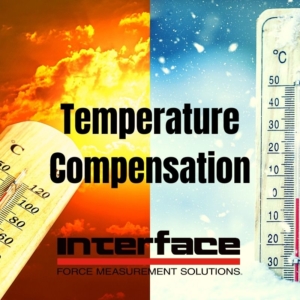Understanding Load Cell Temperature Compensation
 The performance and accuracy of a load cell is affected by many different factors. When considering what load cell will work best for your force measurement requirements, it is important to understand how the impact of the environment, in particular the temperature impact on output.
The performance and accuracy of a load cell is affected by many different factors. When considering what load cell will work best for your force measurement requirements, it is important to understand how the impact of the environment, in particular the temperature impact on output.
An important consideration when selecting a load cell is to understand the potential temperature effect on output. This is defined as the change in output due to a change in ambient temperature. Output is defined as the algebraic difference between the load cell signal at applied load and the load cell signal at no load. You can find more detailed information in our Technical Library.
 Temperature affects both zero balance and signal output. Errors can be either positive or negative. To compensate for this, we use certain materials that are better suited for hot or cold environments. For instance, aluminum is a very popular load cell material for higher temperatures because it has the highest thermal conductivity.
Temperature affects both zero balance and signal output. Errors can be either positive or negative. To compensate for this, we use certain materials that are better suited for hot or cold environments. For instance, aluminum is a very popular load cell material for higher temperatures because it has the highest thermal conductivity.
In addition to selecting the right material, Interface also develops its own proprietary strain gages, which allows us to cancel out signal output errors created by high or low temperatures.
In strain gage-based load cells, the effect is primarily due to the temperature coefficient of modules of elasticity of the force bearing metal. It is common in the industry to compensate for this effect by adding temperature sensitive resistors external to the strain gage bridge which drop the excitation voltage reaching the bridge. This has the disadvantages of adding thermal time constants to the transducer characteristic and of decreasing the output by 10%.
Our load cells are temperature compensated for zero balance. By compensating for zero balance, we can flatten the curve in the relationship between temperature and zero balance. An uncompensated load cell has a much more severe curve, which ultimately affects accuracy and performance.
Interface offers thousands of load cell designs, for standard use and for use in hazardous environments. For instance, rocket engine tests subject our load cells to extremely high temperatures. For use in various maritime industry projects, they can be used in very cold coastlines and even submerged in cold water. No matter where you are, environment influences the load cell’s performance.
 If you are concerned about temperature, Interface provides specifications for every load cell we manufacture. The Interface specification datasheet, as referenced here, is available for download by product. It always includes all the necessary data required to understand the load cell’s ability to perform at the highest-level including compensation range, operating range, effect on zero balance and effect on span.
If you are concerned about temperature, Interface provides specifications for every load cell we manufacture. The Interface specification datasheet, as referenced here, is available for download by product. It always includes all the necessary data required to understand the load cell’s ability to perform at the highest-level including compensation range, operating range, effect on zero balance and effect on span.
One thing that is also unique about our products is that while most competitors only compensate for hot temperatures (60 to 160 degrees Fahrenheit), Interface covers both hot and cold thermal compensation from 15 to 115 degrees Fahrenheit, including adjust and verify cycles.
Watch our recorded webinar Load Cell Basics, where Keith Skidmore discusses temperature compensation. He notes during this informative presentation that if the temperature is changing during a test, it can affect the zero and the output of the load cell. How much effect depends how much temperature is changing and how well the load cell is compensated against the errors, which can be either positive or negative. Good news is they are repeatable from test to test, so if you have large temperature swings you can characterize the system and then subtract out the shift if you know the temperature effect on zero.
Interface Application Engineers are available to answer questions regarding the effect of temperature on force measurement data, or the different ways we can help design a solution to compensate for your environment.









